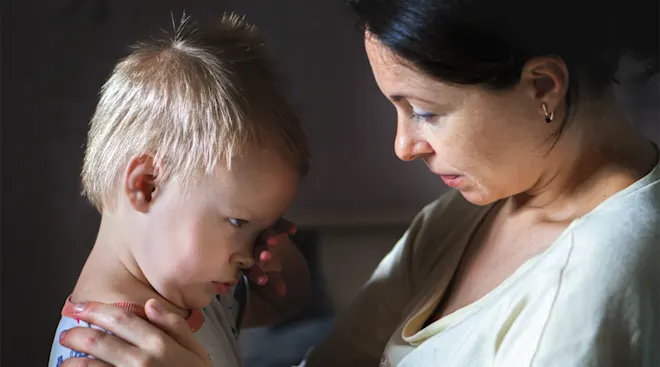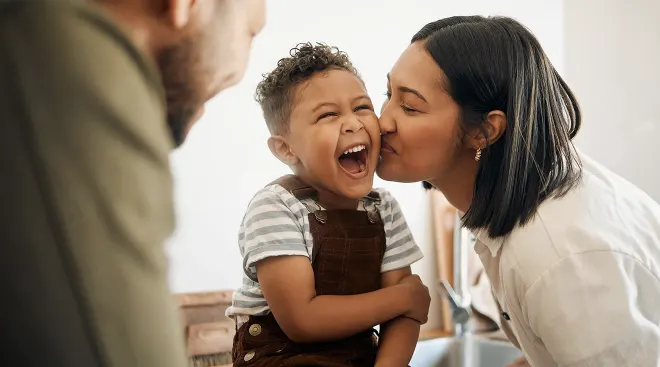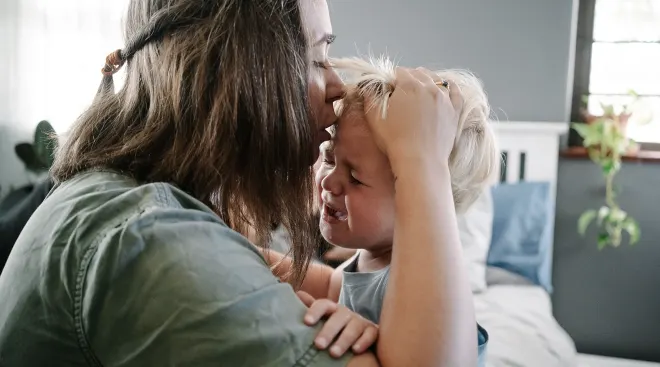Toddler Throwing Things? Here’s How to Deal
What’s the most frustrating part about my toddler throwing things? The very distinct chance of injury he presents each time he does it. A metal toy train near my eye? Sure, why not! Hurling Legos across the room, only to be stepped on? Brilliant idea. And then, there’s the appetite for chaos: If it’s neatly put away into a basket or bin, it must come out and be thrown. Redirecting is the technique that works most to keep my threenager from throwing, but every toddler is different. That’s why I set out to find some tips and tricks on this common early-childhood phenomenon. So, why do toddlers throw things? And how on Earth do you get them to stop? Read on.
The first stage of throwing usually happens at around 9 to 12 months, when babies start intentionally releasing and dropping things they’re holding—like food from their high chair, says Gabrielle Felman, MSEd, LCSW, an early childhood development specialist with Lovevery. Then, toddlers typically start truly throwing things between 12 to 18 months, and “will become more precise and coordinated at throwing a small ball overhand” between 18 and 24 months, she adds.
For starters, a toddler throwing things is developmental, says Felman. “Throwing objects helps little ones practice both fine and gross motor skills,” she says. “Throwing objects builds hand-eye coordination, muscle strength, motor coordination and motor planning. Babies and toddlers are little scientists!” It also helps them explore their environment, “understanding cause and effect, gravity, weight of an object and learning about what happens when an object moves throughout space.”
In addition, throwing can support social and emotional development, Felman says. “Throwing is a form of social play and a very early form of reciprocal play when a baby is participating in releasing an object and then getting it back. Throwing can engage caregivers and elicit reactions … giving baby or toddler social and language feedback.” It’s also a way of testing boundaries to look for a reaction, she adds.
Nia Flowers, MS, BCBA, LBA, an expert in autism, child development and child behavior and quality improvement coordinator at Hopebridge Autism Centers, says throwing can happen when your toddler’s trying to communicate something, especially if they don’t have the words. “They don’t yet have those skills to say, ‘I would like to transition into a different activity,’ and find it easier to take … things off the coffee table and throw them,” she says. “They may throw to signal that they’re finished because they don’t yet have the skills to say, ‘All done.’”
Toddler throwing things (and laughing)? Here are a few things you can do, according to the experts:
- For every “no,” create a “yes.” “As parents, we can nurture their curiosity by giving them opportunities to throw objects while also creating boundaries (i.e. ‘You can’t throw your food’),” says Cindy Hovington, PhD, founder of Curious Neuron, a science-backed parenting consultancy. “Remember that whenever we say ‘no’ to a toddler, we need to teach them what the ‘yes’ to this would look like and give them options.” Felman suggests a way to throw appropriately: “After a diaper change, let your little one throw their diaper into the bin.”
- Model, model, model. If your toddler throws food to show that they’re done with a meal, narrate what you see and take action, suggests Felman. “You might say, for instance, ‘You’re throwing your spaghetti on the floor. That tells me that you’re all done eating. You can say ‘all done.’’ (Even if they can’t say it! Modeling will eventually lead to imitation.)”
- Keep calm. “If your little one [throws] food or objects off their tray, try to stay calm and neutral and ignore it,” says Felman. “If it’s food, leave it. If it’s a cup or spoon, pick it up without saying anything and put it back on the tray. If it continues to happen, you can say, ‘It’s so fun to watch your [cup] fall and make a big sound! Our [cup] stays on the tray. I will hold it.”
- Redirect. “Your baby or toddler can’t yet control their urge to throw and certainly doesn’t understand that throwing may hurt someone else,” says Felman. “They don’t yet have aim or impulse control.” You can redirect them to play with another toy or offer them the opportunity to play safely, she says, saying things like, “‘I see you really want to throw that cup! Here’s a ball you can throw.’”
- Pick your battles. “You want to support your toddler’s growth and development, but there are times and places where throwing can be disruptive,” says Lee Savio Beers, MD, a professor of pediatrics and the medical director for community health and advocacy at Children’s National Hospital. “If they seem to be trying to express themselves or get your attention, take a pause to see what they may be trying to tell you. Often you can learn other ways to read their cues and stop the throwing before it even starts.”
- Be patient. “Toddlers need time, consistency, repetition and a ton of support to change behaviors,” says Felman.
While all children are different, around 24 to 30 months toddlers start to “better understand safety rules and pick up on social cues,” says Flowers. That’s when throwing might slow down, she says, adding that kids often learn what’s appropriate through playing with their peers. If you’re not sure whether a behavior is typical, be sure to check in with your pediatrician.
And if your little one is still throwing things, don’t despair. “Honestly, there’s no magic solution to stop a little one from throwing,” says Felman. “This is a natural and developmentally appropriate way that kids explore and play.”
Please note: The Bump and the materials and information it contains are not intended to, and do not constitute, medical or other health advice or diagnosis and should not be used as such. You should always consult with a qualified physician or health professional about your specific circumstances.
Plus, more from The Bump:
Lee Savio Beers, MD, is a professor of pediatrics and the medical director for community health and advocacy at Children’s National Hospital. She earned her medical degree from Emory University School of Medicine.
Gabrielle Felman, MSEd, LCSW, is an early childhood development specialist and the director of childhood development for popular kids’ toy brand Lovevery. She earned her master of science degree in early childhood education from Bank Street College of Education, as well as her master of science degree in clinical and medical social work from Columbia University. She completed a clinical residency at New York Presbyterian Morgan Stanley Children’s Hospital.
Nia Flowers, MS, BCBA, LBA, is a quality improvement coordinator and Board Certified Behavior Analyst (BCBA) at Hopebridge Autism Centers. With more than a decade of experience working with children, adults and families on the autism spectrum, she brings classroom, residential, clinic and home experience to Hopebridge in her role. Flowers is a powerful force in the workplace, striving for excellence through quality services and advocating for diverse, equitable and inclusive practices throughout the organization. Flowers finds solace in her husband, two children and dog. In her free time, Flowers enjoys reading, watching movies and spending time with her family.
Cindy Hovington, PhD, is the founder of Curious Neuron, a science-backed parenting consultancy that aims to make the science around childhood development more accessible and digestible for parents. She’s also the host of the Curious Neuron podcast. She obtained her master’s degree from Queen’s University and a doctorate in neuroscience from McGill University, both located in Canada.
Learn how we ensure the accuracy of our content through our editorial and medical review process.
Navigate forward to interact with the calendar and select a date. Press the question mark key to get the keyboard shortcuts for changing dates.




















































